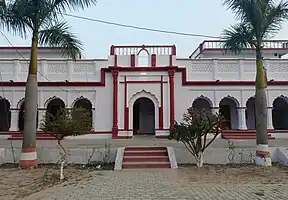Kohra was an estate (taluqdari) of Oudh, British India.[1][2][3] The taluqdari was controlled by the Bandhalgoti clan of Rajputs.[1] Now it is part of Amethi district in Uttar Pradesh, India.
Kohra Estate | |||||||||
|---|---|---|---|---|---|---|---|---|---|
| 1636–1947 | |||||||||
 Flag | |||||||||
| Status | Taluqdari estate | ||||||||
| Capital | Kohra | ||||||||
| Common languages | Awadhi, Hindi | ||||||||
| Religion | Hinduism | ||||||||
| Babu (Ruler or Chief) | |||||||||
• 1636 | Babu Himmat Sah (first) | ||||||||
• 1947 | Babu Beni Bahadur Singh (last) | ||||||||
| History | |||||||||
• Established | 1636 | ||||||||
• Acceded to India | 1947 | ||||||||
| |||||||||
| Today part of | Uttar Pradesh, Republic of India | ||||||||

History
Narwar Nagar of Madhya Pradesh was the native place of this Taluq. Rajkumar Sodh Dev of Narwargarh founded the Amethi state in 966 and became the first Raja of Amethi.[4][5][6] Rajkumar Himmat Sah, the younger son of Raja Bikram Sah, his descendant, established Kohra (estate) on the day of Ganga Dussehra in 1636 and established Lord Chaturbhuj and Shiva temple as the first establishment, then built Kohra Fort, where he was crowned.[2][3][7][8] Babu Himmat Sah was the founder and first ruler of Kohra.[2][3][7][9]
Under British rule, Kohra was scene of numerous battles. Babu Bhoop Singh, the then Taluqdar of Kohra was leader in the Indian Rebellion of 1857. He actively participated in the Awadh War of 1857 and played a crucial role in the siege of Lucknow residency. To counter Colonel Wroughton's advances, he fought battles at Chanda, Amhat, and Kadunala in Sultanpur district.[1][8][10] His property was taken under the management of Court of Wards in 1859. The fort of Kohra was leveled in 1859 by order government; its ruins are still to be seen, covered with picturesque clumps of bamboos. On order of Calcutta High Court, by government removed Court of Wards from Kohra in 1870. Later, the estate was ruled by Babu Shiv Dayal Singh, who was succeeded by his nephew, Babu Devi Dayal Singh.[11][12]
After India's independence on 15 August 1947, Kohra (Taluq) estate was merged in Dominion of India and later Republic of India. Babu Beni Bahadur Singh (died 1968), the last ruler of Kohra, actively participated and donated land in Bhoodan movement.[11][12] Babu Beni Bahadur Singh had no male issue, after his death in 1968, his brother Babu Pratap Bahadur Singh proceeded as Titular ruler of Kohra, who was succeeded by his son, Babu Shiv Bahadur Singh .[11][12] Babu Shiv Bahadur Singh participated in the class boycott of Uday Pratap College, Varanasi in Quit India Movement of 1942.[8] After his death on 28 July 1993 his brother Babu Umanath Singh proceeded as Titular ruler of Kohra.[11][12]
Ravindra Pratap Singh of the Kohra (estate) was elected an MP from Amethi Lok Sabha constituency in 1977 defeating Sanjay Gandhi and was elected as an MLA from Amethi Assembly constituency in 1967.[13][14][15]
List of Rulers
The rulers of Kohra bore the title of Babu.[11] The list of rulers is following as:[11][12]
- Babu Himmat Sah (around 1636)
- Babu Bhoop Singh (1840–1890)
- Babu Shiv Dayal Singh
- Babu Devi Dayal Singh
- Babu Mahaveer Singh
- Babu Beni Bahadur Singh
- Babu Pratap Bahadur Singh (1968–1969)
- Babu Shiv Bahadur Singh (1969–1993)
- Babu Umanath Singh (1993–2017)
Notable descendants
- Babu Bhoop Singh (1820–1890), was prominent leader in the Indian Rebellion of 1857 and led a rebellion against the British forces in 1857.
- Babu Shiv Bahadur Singh (1923–1993), was a Freedom fighter.
- Babu Umanath Singh (1936–2017), was a Professor of Avadh University. He was a founding member of Uttar Pradesh History Congress.[16]
See also
References
- 1 2 3 Mukherjee, Rudrangshu (2002). Awadh in revolt, 1857-1858: a study of popular resistance. Anthem. pp. 179, 195. ISBN 1-84331-075-9. OCLC 843003664.
- 1 2 3 Nevill, H. R. (1903). Sultanpur: A Gazetteer, Being Volume Xlvi Of The District Gazetteers Of The United Provinces Of Agra And Oudh. Allahabad: Govt. Press United Provinces. pp. 101–102.
- 1 2 3 Gazetteer of the Province of Oudh. Oudh Government Press. 1877. pp. 45–50.
- ↑ Lethbridge, Sir Roper (1985). Prominent Indians of Victorian Age: A Biographical Dictionary. Archives Rare Prints. p. 294.
- ↑ Lethbridge, Sir Roper (2005). The Golden Book of India: A Genealogical and Biographical Dictionary of the Ruling Princes, Chiefs, Nobles, and Other Personages, Titled Or Decorated of the Indian Empire. Aakar Books. p. 294. ISBN 978-81-87879-54-1.
- ↑ Lorimer, John Gordon (1970). Gazetteer of the Persian Gulf, ʻOmān, and Central Arabia: Historical. 4 v. Gregg. p. 26.
- 1 2 Millett, A. F. (1873). Report on the settlement of the land revenue of the Sultánpur district. [With] Accompaniments. pp. 155–162.
- 1 2 3 "कोहरा तालुकेदार भूप सिंह ने लिया था फिरंगियों से लोहा". Amar Ujala (in Hindi). 14 August 2022. pp. 1(MyCity). Retrieved 7 October 2022.
- ↑ Manual of Titles for Oudh: Showing All Holders of Hereditary and Personal Titles in the Province. Printed at the Government Press, North-Western Provinces and Oudh. 1889. p. 77.
- ↑ "1857 की क्रांति में अमेठी का विशेष योगदान". Dainik Jagran (in Hindi). 26 January 2010. p. 10.
- 1 2 3 4 5 6 Rathore, Abhinay. "Genealogy of Kohra". Rajput Provinces of India. Retrieved 19 January 2023.
- 1 2 3 4 5 "Kohra Taluk | Talukdari - The History Bro | Infolog.in". 11 July 2023. Retrieved 1 November 2023.
- ↑ "Members Bioprofile". loksabhaph.nic.in. Retrieved 24 September 2022.
- ↑ Aron, Sunita (1 April 2016). The Dynasty: Born to Rule. Hay House, Inc. p. 94. ISBN 978-93-85827-10-5.
- ↑ Kulkarni, V. B. (1977). My Country and My Rulers. Jaico Press. p. 309.
- ↑ Uttar Pradesh History Congress: Proceedings of the I Session, T.N.P.G. College, Tanda, 1985. Uttar Pradesh History Congress. 1986.